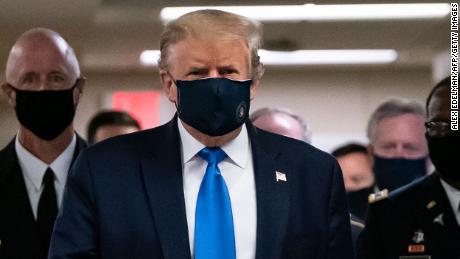(CNN) In a presidency of unprecedented disruption and turmoil, Donald Trump’s support has remained remarkably stable. That stability, paradoxically, points toward years of rising turbulence in American politics and life.
Trump’s approval ratings and support in the presidential race against Democratic nominee Joe Biden have oscillated in a strikingly narrow range of around 40%-45% that appears largely immune to both good news — the long economic boom during his presidency’s first years — and bad — impeachment, the worst pandemic in more than a century, revelations that he’s disparaged military service and blunt warnings that he is unfit for the job from former senior officials in his own government.
Perhaps the newest disclosures, in the upcoming book from Bob Woodward, that Trump knew the coronavirus was far more dangerous than the common flu even as he told Americans precisely the opposite, will break this pattern, but most political strategists in both parties are skeptical that it will.
The durability of both support and opposition to Trump shows how the motivation for voters’ choices is shifting from transitory measures of performance, such as the traditional metrics of peace and prosperity, toward bedrock attitudes about demographic, cultural and economic change.
The immovability of the battle lines in 2020 captures how thoroughly the two parties are now unified — and separated — by their contrasting attitudes toward these fundamental changes, with Trump mobilizing overwhelming support from the voters who are hostile to them, no matter what else happens, and the contrasting coalition of Americans who welcome this evolution flocking toward the Democrats.”
That is certainly what gives Trump a floor: By stoking those cultural war fires you are going to win over a certain share of the electorate that has this more racist and sexist and xenophobic views,” says Brian Schaffner, a Tufts University political scientist who has extensively studied the correlation between political preferences and cultural attitudes.
“But it also prevents him from winning over these other people who would otherwise be conservative or be open to voting Republican, but simply can’t stomach that culture war stuff he is so focused on.”
ELECTION 2020: Send us your stories about voting issuesIn the near term, this alignment has produced a campaign dynamic in which Trump consistently trails Biden, but not so severely that despite all the controversies that might have capsized an earlier incumbent, he cannot squeeze out another narrow win in the Electoral College.
Over the long term, the durability of attitudes toward Trump spotlights the likelihood of a widening rift between two Americas fundamentally diverging in both their exposure to and attitudes about such fundamental dynamics as the nation’s growing racial and religious diversity, rising demands for greater racial equality, changing gender roles and the transition from an industrial to an information age economy.”
When your identity and view of [the nation’s] identity overlaps with your partisan identity so much, it’s hard to ever consider shifting sides,” Schaffner says.
Little change in a year
Biden by any measure retains the upper hand in the presidential race. He holds a consistent lead in national polls and usually leads in five of the swing states both sides consider the most competitive (Michigan, Pennsylvania, Wisconsin, Arizona and Florida), with the two men usually running about even in the sixth (North Carolina).
All of those were states Trump won in 2016; by contrast, the President does not lead in any state that Hillary Clinton carried last time. And polls put Biden within range, to varying degrees, in four other states Trump carried: Iowa and Georgia, especially, but also Ohio and even Texas.MORE ON VOTING
But even Democrats acknowledge that Biden’s advantage isn’t large enough to guarantee him victory in the Electoral College. Because all of the key swing states lean slightly more Republican than the nation overall, even a slight improvement for Trump might put him in position to win 270 Electoral College votes.
What’s more, Biden’s national advantage over Trump isn’t meaningfully different than it was a year ago, despite the searing intervening event of a pandemic that soon will have claimed 200,000 American lives. To take one measure, the Real Clear Politics average of national polls last October showed Biden at 50.1% and Trump at 43.4%; the result last weekend was 50.5% to 43% — virtually unchanged.”
Things are very locked in because the reason you’re voting for Trump is not because of the economy or the response to coronavirus that he’s delivering but rather the image of protecting White people in America,” says Manuel Pastor, a sociologist and director of the Equity Research Institute at the University of Southern California. “He was doing dog whistles at the beginning, then he was doing bullhorns, now it’s like fireworks. And for some people it’s enthralling.”
Mike Murphy, a veteran GOP strategist who now opposes Trump, says that 10 years ago he would have predicted that a public health and economic catastrophe of the coronavirus’ magnitude would have produced a “1980 level wipeout” for Trump and his party.
In that year, dissatisfaction with President Jimmy Carter’s performance propelled not only a landslide win for Republican nominee Ronald Reagan, but also a sweep of 12 Democratic-held Senate seats that carried the GOP to control of the chamber. But such a decisive turn no longer appears possible, Murphy says. “Because politics mirrors [attitudes about] culture, we are kind of stuck,” he says.
Alan Abramowitz, an Emory University political scientist who has extensively studied the role of economic conditions and other fundamentals in presidential outcomes, agrees. Given the magnitude of the pandemic’s impact, “I probably would have expected that it would hurt him more than it has and Trump’s [approval and vote share] numbers would have dropped into the mid-30s,” he told me.
“You would think Biden would be up 15 or 20, not 6 or 7 or 8 points. As long as it stays in that range, there’s still that outside chance … [Trump] can eke out narrow wins in Florida, Michigan, Pennsylvania or Wisconsin and he could still win the electoral vote. I don’t think that’s very likely, but it’s not inconceivable.”
Even before the presidential race began in earnest, Trump’s approval rating had oscillated within a narrower band than those of previous presidents, according to Gallup polling that stretches back to Harry Truman. Just as Trump’s backing hasn’t collapsed during the pandemic, his support didn’t soar during the economic boom times of his presidency’s first years: he’s the only president in Gallup’s history to never win approval from 50% of Americans at any point during his tenure.
This continues a long-term trend of decreasing volatility in public ratings of the presidents; Barack Obama also didn’t receive as big a lift from a rising economy as his predecessors. “If you look at the relationship between economic conditions and presidential approval over time, that correlation weakens considerably during the last two decades,” says Schaffner.
What created the new stability
Both campaign strategists and political scientists point to several factors that have made attitudes about presidents more intractable. A major one is what author Bill Bishop has called “The Big Sort”: the growing tendency of both Democratic and Republican voters to live among people who share their views and to consume media that reinforces their beliefs.
Both of those factors mean partisans are less likely to be exposed to negative information about a president from their party, whether in their daily interactions or in what they read and see.
The blinds may be especially closed for conservatives, with Fox News often registering in polls as the only news source that a majority of Republicans say they trust.”The fragmentation of society and the media fragmentation, living in different worlds … have a [lot] to do with it,” says Democratic pollster Nick Gourevitch.
Also contributing is the decline in the number of true swing voters, who might quickly move toward or away from a president based on current conditions. With more voters firmly locked into each party, “there is maybe 10 or 12% who are untethered independents,” notes Abramowitz. “And those folks don’t pay very much attention to what is going on, so they are not moved much by events either.”
But the most powerful factor in the new stability may be the shift in the basis of voters’ allegiance to the parties. Increasingly, campaign strategists and political scientists agree, voters are choosing between the parties more on their views about fundamental demographic and cultural change than on their immediate financial circumstances or even their views of economic policies, such as taxes, spending and regulation.
Partisan allegiances grounded in these fundamental measures of personal and national identity — such as whether the nation must do more to assure equal opportunity for people of color and women — appear highly resistant to reconsideration based on immediate events.
In important research, Schaffner and his colleagues found that the denial that racism or sexism exists in America was the best predictor in the 2016 election of support for Trump, far more than any measures of economic distress. On the other side, Schaffner found that the belief that racism and sexism are serious problems predicted support for Clinton more powerfully than economic attitudes, as well.”
Now the parties are very clearly sorted on issues of identity politics,” Schaffner says. “If you have fairly racist or sexist views you are … very likely to be a Republican. And if you have the opposite views you are very likely to be in the Democratic Party.”
Attitudes on race and gender play a big role
Like many experts, Schaffner says a political alignment that sorts the electorate along that fault line is simultaneously more stable and more confrontational. “Because identity politics has become so clearly overlapping with partisan politics, it makes those divisions all the more heated and uncompromising,” he told me.
“It’s much easier to compromise on what should the marginal tax rate be, or what’s a reasonable date for net-zero carbon emissions, but people generally don’t want to compromise on issues related to how much work you should do to … make sure that racial minorities or women are treated equally.
People are much less compromising on those views, so once party politics becomes concentrated on that stuff the coalitions become much more stable.”With Trump basing so much of his campaign on charging that a Biden victory would unleash mobs of protesters in suburbia — and in the process appealing so openly to White racial resentments — Schaffner says it’s highly likely that attitudes about race relations and gender roles will predict support in the presidential contest even more powerfully in 2020 than in 2016.
Already, striking recent polling from the nonpartisan Pew Research Foundation has found that the gap in attitudes about demographic and social change is even wider between voters backing Trump and Biden than it was between supporters of Trump and Clinton in 2016.
In a poll released last week, Pew asked voters if Whites have advantages in society that Blacks do not. It found that the share of Democratic voters and all registered voters who agree has increased since 2016 (to 9 in 10 of the former and almost 6 in 10 of the latter), but three-fourths of Trump supporters still reject that idea, slightly more than in 2016.
Similarly, while about 4 in 5 Democratic voters and 55% of all registered voters say women still face significant obstacles in getting ahead (both up slightly since 2016), nearly three-fourths of Trump supporters reject that idea as well, also slightly more than four years ago.
The share of Trump voters who say the growing number of immigrants “threatens traditional American customs and values” has declined since 2016, but still two-thirds of them express that opinion; that compares with just 1 in 7 Democratic voters and fewer than 2 in 5 registered voters overall.
Further detail on the results provided to CNN underscore how powerfully attitudes on such questions now drive allegiance to the two parties. Even among voters in the same demographic group, Pew found, there’s an enormous gulf in views on these questions between those supporting Biden and those supporting Trump.
Three-fourths of the college-educated Whites backing Biden, for instance, say it’s “a lot more difficult” to be Black than White in America today; fewer than 1 in 12 college-educated Whites backing Trump agree. About four-fifths of both college- and non-college-educated Whites backing Biden agree that women still face obstacles in getting ahead; only about one-fourth of the comparable Whites backing Trump agree.
Almost three-fifths of the women backing Trump say the obstacles inhibiting women “are now largely gone”; less than one-seventh of the women supporting Biden concur.In another recent national survey, the nonpartisan Public Religion Research Institute likewise found that while Democrats are much more likely than in 2015 to see police shootings of unarmed Black men as part of a pattern, about four-fifths of Republicans still describe such shootings as isolated events, substantially widening the gap between the parties.
In that polling, Republicans were slightly more likely than in 2015 to describe Confederate monuments as a symbol of Southern pride rather than racism, while Democrats have moved sharply in the opposite direction.All of these results underscore how Trump has intensified the long-term process of reconfiguring the parties more along lines of cultural and racial attitudes than economic class.
That’s provided him with a seemingly unshakable grip on the groups most alienated from the demographic and cultural changes remaking America: Whites who don’t hold college degrees, who live in rural areas or who identify as Christians, particularly evangelical Christians.But it’s simultaneously sentenced Trump and his party to huge deficits among young people and people of color, as well as White voters holding at least four-year college degrees.
With many of those well-educated Whites recoiling from Trump’s definition of the GOP, polls show him on track for the largest deficit in the history of polling for a Republican nominee among them.
Views are only intensifying
These divisions, of course, aren’t absolute: Polls show that compared with 2016, Trump may be positioned to improve somewhat among Black and Hispanic men while Biden may gain some among non-college White women.
As Schaffner notes, some voters remain conflicted about these demographic and cultural changes and are open to switching sides depending on their assessment of the individual nominees; with Biden, he believes, Democrats may win more older and non-college Whites who probably lean slightly right on these questions than they might have with a more liberal nominee.
The flip side, others note, is that the relatively centrist 77-year-old Biden may not inspire as much turnout as other potential nominees from younger people of color who consider Trump a racist.Gourevitch also points out that even if the pandemic hasn’t significantly reduced Trump’s support, it has significantly changed the terms of the 2020 debate in two respects.
The outbreak, he notes, has both complicated the economic argument Trump wanted to make for reelection and demonstrated tangible consequences for “the failures of his style of leadership in a way that wasn’t obvious before.”
But given all that’s happened — from impeachment to the pandemic — the most striking thing about the demographic and geographic patterns of support for Biden and Trump is how similar they look to the partisan dynamics in the 2016 and 2018 elections.
If Biden holds his national lead, Democrats will win the popular vote in November for the seventh time in the past eight presidential elections — something no party has done since the formation of the modern party system in 1828.
That underscores the reality that the groups drawn toward the Democrats in this cultural resorting of the electorate — what I’ve called the “coalition of transformation” — are clearly larger at this point than the competing “coalition of restoration” aligning with the GOP.
That doesn’t guarantee the Democratic coalition will consistently control the federal government, because the Electoral College and two-senator per state rule magnify the influence of the Whites most drawn to the GOP.
But even so, Robert P. Jones, founder and CEO of the Public Religion Research Institute, says the White constituencies most hostile to demographic and cultural change will likely become more embittered through the 2020s as evidence mounts that they no longer constitute the nation’s majority. Just since 2008, he notes, White Christians have fallen from about 54% to 44% of the population; that decline, he believes, will become vastly more tangible for them if Trump loses in November.”
This White Christian base has been shrinking and becoming more shrill at the same time: I think those two things are related,” says Jones, author of the recent book “White Too Long,” a history of Christian churches and racial bias.Trump’s relentless rhetorical salvos against immigrants, “mobs” and African American leaders from politics to sports and his insistence that religious traditions (like Christmas) are under siege all inflame a deep-rooted anxiety among conservative White Christian voters, Jones notes.”
Particularly White Christian folks really did think they were the country,” he says. “So if you take that really seriously, [as] something they believed to the core of their being, then what’s becoming abundantly clear is that that is not true. But that is a foundational piece of their self-understanding. To fight tooth and nail for something that is going to actually undermine your basic identity is not too surprising. It runs just that deep.”
And even as conservative White Christians feel increasingly embattled, it’s clear from the unprecedented protests that followed the death of George Floyd in Minneapolis in late May that many younger Americans — especially but not exclusively the rapidly growing cohort of young people of color — feel increasingly impatient about securing greater racial (and gender) equity.Trump has deliberately exacerbated America’s divisions, but even if he loses, those contrasting visions of national identity will remain on a collision course.
In that way, this year’s stability anticipates the volatility ahead.With the Democratic Party identifying much more unreservedly than even 10 or 20 years ago with the demands for change, and Trump so clearly stamping the GOP in opposition to all of them, the grinding trench warfare between these competing coalitions in the 2020 race probably only previews the struggle looming through the 2020s.Pastor isn’t alone when he grimly predicts, “We’re really getting ready for a very deep culture war coming.”






